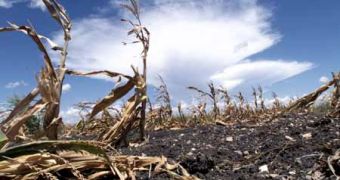Thanks to climate change and the environmental shifts it brought forth (i.e. an increase in global average temperatures, droughts and other extreme weather manifestations), the American and the Canadian prairie might soon be hit by dust storms similar to those that occurred in the 1930s, during the Dust Bowl.
The fact that the US was recently hit by severe drought conditions is no news, and several studies have pointed out the fact that the regions that took the hardest blows are those in North and South Dakota, Nebraska, Kansas, Oklahoma, Texas, Montana, Wyoming and Colorado.
As explained on Scientific American, some of these American regions were also hit by rather powerful winds during mid-October, something that translated into the formation of numerous and powerful dust storms.
Specialist Craig Cox from the Environmental Working Group made a case of how, although this second Dust Bowl might not foster dust storms as impressive as those in the 1930s, the fact remains that agricultural practices will be severely affected.
“If the drought holds on for two or three more years, as droughts have in the past, we will have Dust Bowl conditions in the farming belt,” this researcher said.
“It could be in a sense an invisible Dust Bowl—not like the big storms before, but withered crops, dry streams and other disasters that accompanied the Dust Bowl. Wind erosion is tremendously damaging and hard to control,” he went on to add.
One other problem is that said environmental changes will also place added strain on the already vulnerable water resources found in this part of the world, meaning that irrigation systems stand to lose their efficiency.
The specialists who looked into this issue explain that there are ways of getting around climate change and global warming, but that all involve changing the ways in which people grow crops and livestock.
As research ecologist Wayne Polley puts it, “Major changes in agricultural land use will mean changes in our eating habits and our family budgets as well.”

 14 DAY TRIAL //
14 DAY TRIAL //